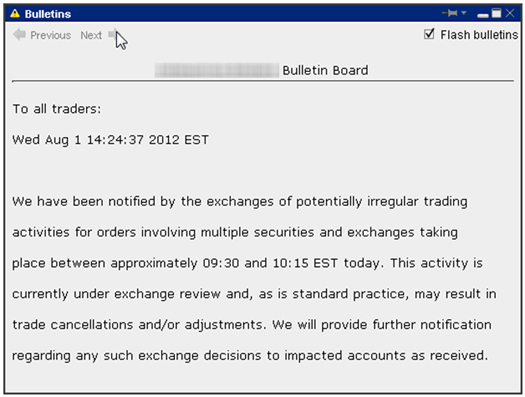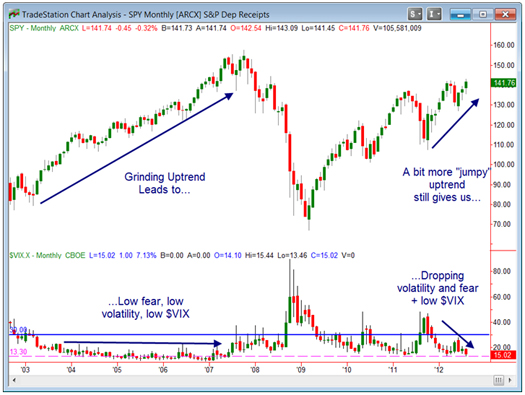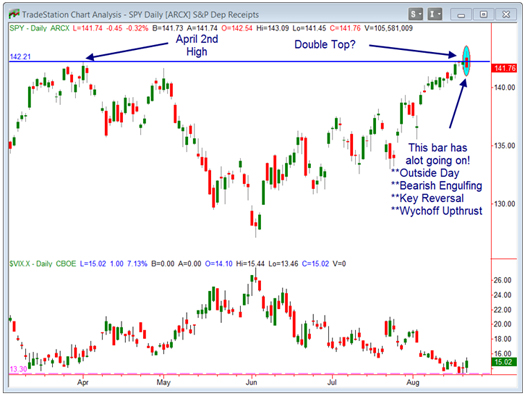Tharp's Thoughts Weekly Newsletter (View On-Line)
-
Article Is High-Frequency Trading Bad? by R.J. Hixson
-
-
TradingTip A Five-Year Low and a Double Top by D.R. Barton, Jr.
This September, Ken Long returns to teach highly profitable short-term systems that generate frequent and profitable trades in his Mechanical Day and Swing Trading workshop, then demonstrates how to apply disciplined discretion to his swing and day system rules in a live Discretionary Swing and Day Trading workshop.
Click Here to Learn More.
 Is High-Frequency Trading Bad? Is High-Frequency Trading Bad?
Revisiting the Flash Crash
by R.J. Hixson
When you fly, do you ever hear a ding or some other kind of alert and wonder what it means?
I had one of those experiences a few weeks back while I was trading. There I was on the afternoon of August 1 with four closed trades (two losses, two wins, net positive on the day), when, all of a sudden, my platform sounded an alert horn. Usually, these alerts notify traders that some set of instruments or some exchange is having technical difficulties. This one, however, was more intriguing, so I took a quick screen capture of it:

It reminded me a bit of the alerts I saw the day after the Flash Crash of May 2010.
The Flash Crash from a Cary Viewpoint
The Flash Crash happened on an afternoon when we were teaching a Systems Development Workshop here in Cary, NC. The market had been heading down throughout the day and one of the attendees was a money manager who left the room frequently to speak with his partner, who was talking with nervous clients. At one point after lunch, he checked his phone and blurted out, “The Dow just lost 400 points,” which generated concerned murmurs in the room. We took a break and everyone opened up a laptop or pulled out a phone. I felt lucky to be able to check on some short swing positions I had open. The market seemed to recover a bit, so we restarted and finished up the workshop for the day. The next day, I saw another alert, similar to the one above, but a bit lengthier. It wasn’t until days later, after we finished the Systems workshop, that I realized how many traders had been affected directly or indirectly by the event.
Explanations, Hypotheses and Aftermath
The early and simple explanations, like a fat finger, a technical glitch at the exchange or an oversized sell order, were a bit inadequate. The CFTC/SEC staff released their report a few months later, which did little to provide plausible and complete causes. In a paper published months after the event, one academic team hypothesized that a new price and liquidity dynamic in the market structure caused the event—a record-high level of order flow toxicity (it’s an interesting theory, and for more technically minded readers, there could be tradable system ideas in the research paper, which you can read for yourself here).
In any case, the Flash Crash caused a lot of losses, frustration, and a great deal of opining about the volatility-inducing dangers of high-frequency/algorithmic/quantitative traders (shortened to HFTs for our purposes). A letter on a related subject from Direct Edge to the SEC summed up the aftermath well: “Misconceptions... have, to date, stirred a passionate but ill-informed debate.”
The ill-informed debate includes a common refrain that has continued now for two years—that the market volatility since 2008 has been generated by HFTs, and that HFTs are bad for the markets. Mark Cuban went so far as to call HFTs “the ultimate hackers” (read the Q&A here). However, in a recent audio interview, James Thomas, Director of Research for high frequency trading firm Headlands Technologies, pointed out that during the relatively quiet markets between 2003 and 2007, everyone was blaming HFTs for the opposite effect—for taking all the volatility out of the market. Because there’s always something to dislike about the markets, people who are looking for something to blame will always find it.
Flash Crashes That Weren’t
While we haven’t seen another flash crash, recent incidents like the aborted BATS IPO and the disorderly Facebook IPO remind us that even market-makers and exchanges make major missteps that can trigger unforeseen market reactions. The Knight Capital errant software trade executions of August 1 highlight risks induced specifically by automated trading. In fact, those very Knight Capital trades were the reason behind the alert bulletin I received from my broker that day.
How do you deal with these risks? HFTs are part of the markets now, whether anyone likes it or not. You might take a moment to consider your responses to the following questions:
- How much do you know about HFTs?
- Does it affect your trading day to day? If so, how, and to what extent?
- When you hear an opinion about HFTs from an outspoken critic, an outspoken supporter, or an “unbiased” source, does it add to your knowledge about HFTs and the market? Do you consider possible agendas in expressed opinions?
- How much do you need to know about this topic vs. others (like your trading objectives, or business plan, or position sizing strategies, or exits)?
Analogous to Flying
Any safety official will tell you that airplane crashes are never caused by a single malfunction or pilot error. Invariably, a whole series of smaller events leads to a crash, or, in proper safety parlance, “a collision with the ground.” I suspect that a sequence of events was probably behind the Flash Crash, too—but do I need an exhaustive understanding of why it happened? Not really. Rather, I believe that I need to understand my answers to the questions above and acknowledge my beliefs about high frequency trading. I also need to acknowledge that HFTs may be systemically related to market events for which I need to plan accordingly.
When I board a plane, I know there are risks, but I don’t let that stop me from flying. Years of Air Force training helped me develop an awareness of flight safety and emergency planning. I know how to put on an oxygen mask, how to open the emergency doors should I need to, and where my seat is in relation to the exit rows. In other words, I accept the risks because they're tolerable, and because I’m prepared for them. Similarly, my training through the Van Tharp Institute has helped me develop an awareness of risk management and the need to plan for worst-case scenarios in the markets.
We may yet get to see how all that preparation helps at some point.
In the meantime, take care, and trade well.
About the Author: R.J. Hixson is a devoted husband and active father. At the Van Tharp Institute, he researches and develops new products and services that will help traders trade better. He served as a navigator in the USAF on the E3 AWACS and can be contacted at “rj” at “vantharp.com”.
Trading Education
Workshops
Sept 8-9
$250 |
Sensory Enlightenment Weekend with an American Buddha
With Stuart Mooney (Only a few seats remain) |
Sept 21-23 |
Mechanical Systems for Day and Swing by Ken Long
Featuring Highly Profitable Short-Term Systems for Frequent and Profitable Trades!
Learn six strategies in three days. Click here to learn more about these strategies. |
Sept 24-28 |
Discretionary Live Trading by Ken Long
Coaching and demonstration of what to do in preparation for the trading day, trading during market hours, and how to recap the lessons for the day after market close. Learn more... |
October 6-7 |
Oneness Awakening Workshop
Learn ancient meditation practices to help open and balance your mind and spirit. |
October 19-21 |
Peak Performance 101
Van Tharp's Signature Workshop |
October 23-26 |
Peak Performance 202
with Van Tharp and Dr. Libby Adams |
Nov 9-11 |
Forex Trading Systems Presented
by Gabriel Grammatidis |
Nov 13-15 |
New! Great Super Trader Systems
Intraday • Automated Swing • Bear Recovery |
To see our full workshop schedule, including dates, prices and location, click here.
Trading Tip
 A Five-Year Low and a Double Top? A Five-Year Low and a Double Top?
by D.R. Barton, Jr.
More and more, we seem to be living in a market of extremes. Market Profile creator Pete Steidlmayer made an interesting observation when I sat with him some time ago in his office inside the Chicago Board of Trade. Pete said that markets are making deeper retracements because of the types of trades being made. Large institutions and hedge funds control more and more money, so the market is now made up of 10 people trading 1,000 lots each instead of 1,000 people trading 10 lots, as it used to be. This leads to markets moving rapidly from extreme to extreme, especially in terms of indicator readings.
This polar market is at it again. Regular (and long-suffering) readers of this column know that the new “risk-on, risk-off” dynamic tends to cause steeper and more rapid swings in both directions. Lately, we’ve been in one of those swings—this time, to the up side.
As always, the meaningful question is, “Where do we most likely go next?” Are we in the middle phase of a bigger push up, or is this trend getting tired? In just the last few days, several interesting things happened that may give us some insight into the state of the current move.
For the First Time in Five Years…
Once again, I find myself focusing on one of my favorite short-term indicators: the CBOE Volatility Index ($VIX). People like to call this the “fear index,” and in the last few days, it has hit its lowest level since the times long before the real estate/credit bubble burst. To be precise, the $VIX hit a low at 13.30 on Friday 8/17. The last time it was that low was on June 20, 2007!
Here’s a monthly bar chart that shows the S&P 500 with the $VIX running along the bottom:

Another noteworthy technical occurrence showed up on Tuesday (8/21). In this chart of daily S&P 500 bars, we see a really interesting confluence of technical attributes in yesterday’s candlestick:

We need to bear in mind that technical analysis is just about probabilities. That said, the coincidence of a potential double top at a multi-year high combined with a multi-year low in the $VIX should at least put us on high alert for a trend reversal.
Great Trading, D. R.
About the Author: A passion for the systematic approach to the markets and a lifelong love of teaching and learning have propelled D.R. Barton, Jr. to the top of the investment and trading arena. He is a regularly featured guest on both Report on Business TV and WTOP News Radio in Washington, D.C., and has been a guest on Bloomberg Radio. His articles have appeared on SmartMoney.com and Financial Advisor magazine. You may contact D.R. at "drbarton" at "vantharp.com".
Disclaimer
Scratch and Dent Sale
We have a few sets of imperfect or older home study courses on clearance at deep discounts.
$300-$500 off!
Click here for the Scratch and Dent Details
Ask Van...
Everything we do here at the Van Tharp Institute is focused on helping you improve as a trader and investor. Consequently, we love to get your feedback, both positive and negative!
Click here to take our quick, 6-question survey.
Also, send comments or ask Van a question by clicking here.
Back to Top
Contact Us
Email us at [email protected]
The Van Tharp Institute does not support spamming in any way, shape or form. This is a subscription based newsletter.
To change your e-mail Address, click here
To stop your subscription, click on the "unsubscribe" link at the bottom left-hand corner of this email.
How are we doing? Give us your feedback! Click here to take our quick survey.
800-385-4486 * 919-466-0043 * Fax 919-466-0408
SQN® and the System Quality Number® are registered trademarks of the Van Tharp Institute
Back to Top |